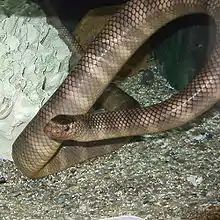Black-banded sea krait
The black-banded sea krait (Laticauda semifasciata), also known commonly as the Chinese sea snake, is a species of venomous snake in the subfamily Laticaudinae of the family Elapidae. In Japan it is known as erabu umi hebi (ja:エラブウミヘビ), and in Okinawa as the irabu. It is found in most of the warm waters of the western Pacific Ocean.
| Black-banded sea krait | |
|---|---|
 | |
| Scientific classification | |
| Kingdom: | Animalia |
| Phylum: | Chordata |
| Class: | Reptilia |
| Order: | Squamata |
| Suborder: | Serpentes |
| Family: | Elapidae |
| Genus: | Laticauda |
| Species: | L. semifasciata |
| Binomial name | |
| Laticauda semifasciata | |
| Synonyms[2] | |
This sea snake frequents coral reef areas. It has a short head, thick trunk, and no easily discernible neck. The tail is simply extended skin, spread wide like a fin, and unsupported by any bony projections from the vertebral column. The stomach is comparatively wide. Massing together near the shore, it breeds between narrow cracks in the reef and in caves. It is a nocturnal snake, rarely seen during the day. It breathes air; so it breaks the surface at least once every six hours.
It is too slow to catch fish in a straight chase, so it hunts for fish hiding in the coral. Alternately, gathering in the hundreds, the black-banded sea krait forms hunting alliances with yellow goatfish and bluefin trevally, flushing potential prey from narrow crannies in a reef the same way some moray eels do.[3][4] The bite is highly venomous and paralyzes the prey. Females lay their eggs on land.
Generally, the species is found in Fiji, southern Japan and Singapore. Its venom is ten times stronger than that of a cobra, making it extremely dangerous. The snake does not attack humans unless it feels threatened or provoked.
The erabu snake is a winter staple in southern Japan, where it is believed to replenish a female's womanhood. Irabu soup irabu-jiru (ja:イラブー汁)[5] is said to taste like miso and a bit like tuna. This soup was a part of the royal court cuisine of Ryukyu Kingdom; it is thought to have analeptic properties.
Development
Males and females of the black-banded sea krait reach sexual maturity at snout-vent lengths (SVL) of 70 and 80 cm (28 and 31 in), respectively. Females lay 3–7 eggs that hatch after 4–5 months.[6] L. semifasciata can reach a total length (including tail) of 170 cm (67 in).[7]
Location
As stated before, the black-banded sea krait can be found in the warm waters of the western Pacific Ocean. That being said, researchers have recently found L. semifasciata in the waters surrounding southern South Korea. This area is located outside its "typical distribution range (Japan, China including Taiwan, Philippines and Indonesia)." [8] The same researchers state that the black-banded sea krait has been dispersing northward from its typical distribution range due to climate change which has caused deterioration of its habitat.[8]
References
- Lane A, Gatus J (2010). "Laticauda semifasciata". IUCN Red List of Threatened Species. 2010: e.T176721A7290432. doi:10.2305/IUCN.UK.2010-4.RLTS.T176721A7290432.en.
- Species Laticauda semifasciata at The Reptile Database . www.reptile-database.org.
- "Black-banded sea krait photo - Laticauda semifasciata - G78940". ARKive.org. Archived from the original on 2012-10-08. Retrieved 2016-07-17.
- "Archived copy". Archived from the original on 2012-03-11. Retrieved 2015-08-18.CS1 maint: archived copy as title (link)
- "Okinawa Gourmet Guide : Sea snake soup (Irabu-jiru) | Website of Okinawa Sightseeing information Okinawa2Go!". En.okinawa2go.jp. Archived from the original on 2013-02-18. Retrieved 2016-07-17.
- Tu MC, Fong SC, Lue KY (1990). "Reproductive biology of the sea snake, Laticauda semifasciata, in Taiwan". Journal of Herpetology. 24 (2): 119–126. doi:10.2307/1564218. JSTOR 1564218.CS1 maint: multiple names: authors list (link)
- Breuer, Hans; Murphy, William Christopher (2009–2010). "Pseudolaticauda semifasciata". Snakesoftaiwan.com. Retrieved 7 October 2012.
- Park J, Kim I-H, Fong JJ, Koo K-S, Choi W-J, Tsai T-S, et al. (2017). "Northward dispersal of sea kraits (Laticauda semifasciata) beyond their typical range". PLoS ONE 12 (6): e0179871. https://doi.org/10.1371/journal.pone.0179871
Further reading
- Schlegel H (1837). Essai sur la Physionomie des Serpens [Volume 2]. Partie Descriptive. Amsterdam: M. H. Schonekat. 606 + xv pp. (Platurus semifasciatus Reinwardt, new species, p. 516). (in French).
